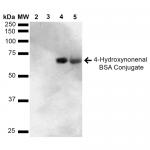Lipid Peroxidation
Lipid peroxidation occurs when oxidizing agents attack carbon-carbon double bonds found in unsaturated lipids. Lipids are a structurally diverse class of hydrocarbons that carry out multiple physiological functions within organisms including cell signaling and energy production. A further critical function is to provide and maintain structural integrity and fluidity to cellular membranes.
Targets of lipid peroxidation are polyunsaturated fatty acids as well as glycoproteins, phospholipids and cholesterol found in cellular membranes.
Low levels of lipid oxidation are normal within a cell and act to stimulate the adaptive response. Increased levels of membrane lipid peroxidation however, can result in loss of lipid function and structural integrity resulting in cell death.
In addition to membrane degradation, oxidation end-products have been found to damage cell viability through their mutagenic and toxic properties. Overall, these downstream functional consequences facilitate the development of disease and premature aging.
Reactive Oxygen Species (ROS)
Principal oxidants in lipid peroxidation are reactive oxygen species (ROS, or free radicals). Both endogenous and exogenous ROS sources contribute to cellular levels.
Examples of endogenous sources include the electron transport chain by-products or bacterial phagocytosis, while the former include UV exposure and ingestion of toxic substances.
Under situations of oxidative stress, ROS are acting in a damaging capacity resulting from an imbalance between free radicals and antioxidant biomolecules. Species with the greatest known impact on lipids are the hydroxy and the hydroxyperoxide radicals.
Mechanism of Lipid Peroxidation
The lipid peroxidation mechanism proceeds via three-steps:
- Initiation – involves proton extraction from the allylic carbon on the unsaturated lipid.
- Propagation – occurs with hydrogen removal from additional lipid molecules, resulting in a chain reaction.
- Termination – occurs when an antioxidant donates a hydrogen atom yielding a nonradical product.
The self-propagating nature of the chain reaction results in amplification with substantial membrane damage and cytotoxic effects originating from a single free radical molecule.
Reactive Aldehydes
Direct in vivo quantification of free radicals can be complex. Lipid peroxidation yields the formation of primary phosphatidylcholine hydroperoxide (PCOOH), which in turn generates reactive aldehydes.
These critical secondary molecular products include malondialdehyde (MDA), 4-hydroxynonenal (4-HNE), and acrolein, among others and can be used as oxidative stress markers.
Malondialdehyde (MDA)
Malondialdehyde (MDA) is the biomarker in greatest diagnostic use, due to its molecular stability. This three-carbon, low-molecular weight aldehyde has a strong affinity for amino acids, which results in adduct formation to both free amino acids and proteins.
Increased MDA levels have been found at correlating levels in breast cancer, and lung cancer patients. Other diseased states with elevated MDA levels include diabetes and Alzheimer’s disease.
Multiple laboratory techniques exist for quantification of MDA levels, including the thiobarbituric acid reactive substances (TBARS) assay.
In addition to use as a biomarker, MDA has been shown to have mutagenic effects on tissues themselves as adduct formation can result in DNA cross-linking.
4-hydroxynonenal (4-HNE)
4-hydroxynonenal (4-HNE) is a highly studied secondary product generated in relatively high abundance. This reactive electrophilic molecule readily forms adducts with glutathione, proteins, and DNA.
Due to its high reactivity, 4-HNE is classified as the secondary product with the greatest toxicity. This dual functioning molecule acts in a positive role within the cell at low levels and is involved in signal transduction, cell proliferation, and differentiation.
Elevated levels however can inhibit gene expression and its cytotoxic effects can promote diseased states including cancer, neurodegenerative disorders, Alzheimer’s disease, and Parkinson’s disease.
Lipid peroxidation research requires a great diversity of life science products. StressMarq is dedicated to developing cutting edge research products to aid in the study of lipid peroxidation.
View all Lipid Peroxidation Products
